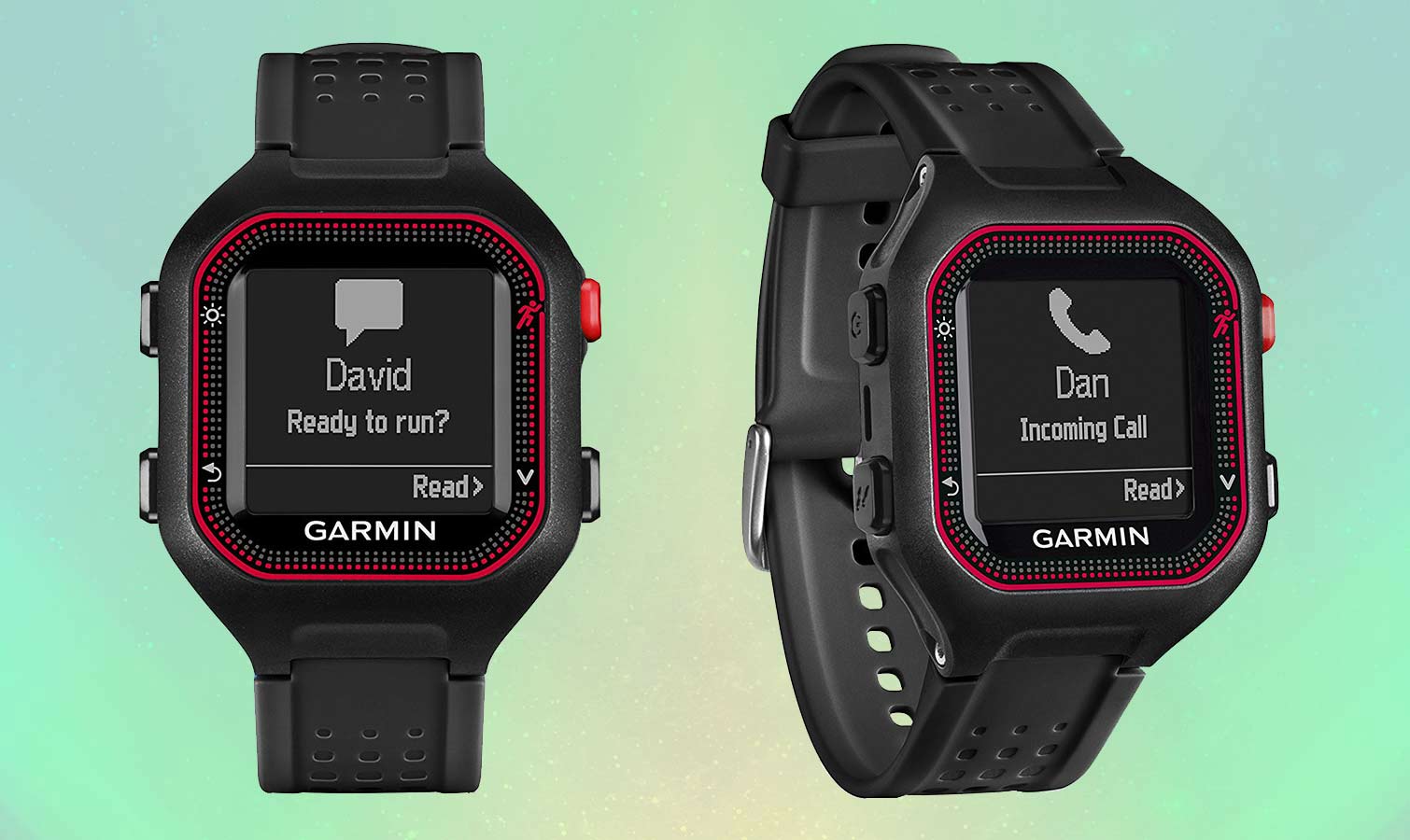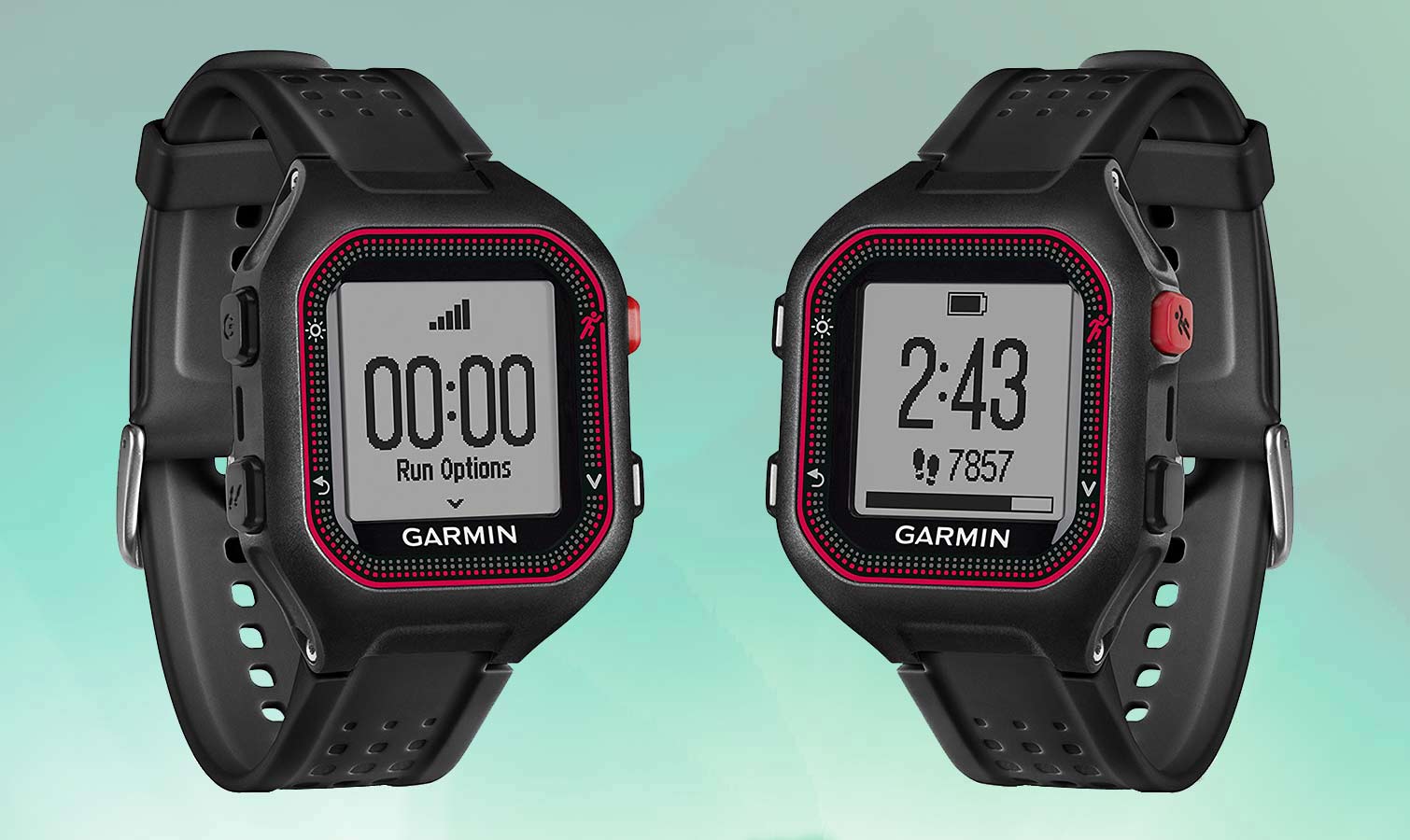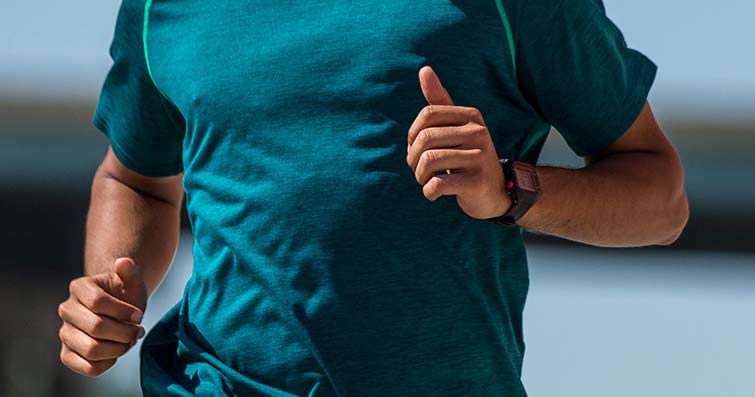Tom's Guide Verdict
The Garmin Forerunner 25 is a solid no-frills running watch for new runners. It doesn't do a lot, but what it does, it does well.
Pros
- +
Long battery life
- +
Easy to use
- +
Waterproof
- +
Inexpensive
Cons
- -
Simple display
- -
No heart rate monitor
- -
No sleep tracking
Why you can trust Tom's Guide
The Garmin Forerunner 25 ($139) is a no-frills running watch. The screen is black and white, there's no heart rate monitor (HRM), and it tracks only runs. But the Forerunner 25 gets the basics right and is the best fitness tracker for someone new to running who doesn't want or need a lot of bells and whistles.
Design
The Forerunner 25 comes in four color combinations: white/pink, black/purple, black/blue and black/red (the version I reviewed). The black/blue and black/red versions have slightly bigger watch faces (1.57 x 1.85 inches) than the white/pink and black purple versions (1.38 x 1.73 inches); both sizes are 0.55 inches thick. The larger watches also come with a longer-lasting battery.

The black-and-red watch is the most muted design of the four; only the top-right Activity button and a thin border around the watch face are red. This version still looks like a running watch, but it could blend in with a work outfit. For the other three designs, the band as well as the Activity button and the watch border are the secondary color. I'm not sure that I'd wear any of these with a sport coat, though I tend to be a pretty conservative dresser.
Setup
Like other Garmin devices, the Forerunner 25 is easy to set up. After creating a Garmin Connect Mobile account, the watch syncs to the app via Bluetooth. This is an upgrade over the Forerunner 15, which doesn't offer Bluetooth syncing; instead, you had to plug that watch into your computer via USB. With the newer watch, after Bluetooth syncing, you enter your height, weight and birth date, which the Forerunner 25 will use to estimate the number of calories burned during your workouts.

Through Garmin Connect, users can also enable smartphone notifications on the Forerunner 25. This is another upgrade over the Forerunner 15, which, due to a lack of Bluetooth connectivity, couldn't sync notifications.
Get instant access to breaking news, the hottest reviews, great deals and helpful tips.
Interface
As you would expected from a low-cost running watch, the Forerunner 25 has a basic design. The 128 x 128-pixel screen is black and white, and though the large numbers have curves, you can see the individual pixels. It's still quite an upgrade over the Forerunner 15's 55 x 32-pixel screen, which is smaller than most of today's fitness trackers.
MORE: Best Fitness Trackers for Running, Swimming and Training
Not surprisingly, the Forerunner 25 doesn't have a touch screen. Instead, the watch has four buttons: an Activity button (which is a different color than the others) and a down-scroll arrow on the right side, as well as a back button and a backlight button on the left side. Every time you press a button, the watch beeps, which is handy when you're running but a bit annoying when you're sitting in the office. Fortunately, you can turn the beeping off.
Daily Use
Like other Garmin devices, the Forerunner 25 features a Move bar that encourages you to get up for a quick walk if you sit for too long. About 250 steps will clear the Move bar.
Hitting the back button in the watch's main screen cycles through your daily activity stats: steps taken, daily step goal, miles walked/run and calories burned. The Forerunner 25 itself doesn't include an embedded HRM, though a strap-on HRM is available as part of a $169 bundle that also includes the watch. The lack of an HRM is understandable given the price, though embedded heart-rate monitors can be found in less-expensive activity trackers such as the Huawei Band 2 Pro ($69).

The Forerunner 25 is water-rated to 5 atmospheres, which means you can wear it swimming, though the watch doesn't track swim workouts. If nothing else, you can wear it in the shower without worry.
One downside to the Forerunner 25 is that it doesn't track sleep, which its predecessor, the Forerunner 15, did.
Activity Use
The simplicity of the Forerunner 25 stood out during my runs — in good ways and in bad.
To start a run outside, you hit the Activity button, wait for the watch to get a GPS signal and then hit the button again. Having reviewed devices that require quite a bit of scrolling or touch-screen swiping just to start a simple workout, I appreciated being able to just press a button twice and go. Plus, the Forerunner 25 typically picked up a GPS signal within 1 minute, and often within 15 seconds — less time than it takes me to sit on the steps and tie my shoes. The Forerunner 25 will also track indoor runs, which the Forerunner 15 couldn't do unless you used a foot pod.

The Forerunner 25 supports a few other run types. For example, you can opt to run for a specific distance, time or number of calories burned, and the watch will count down until you reach this goal. You can also use the Virtual Pacer option, set up a series of run/walk intervals or receive heart rate notifications if paired with a heart rate monitor. These are helpful features for users new to running who are using a program such as Couch to 5K, which includes both run/walk workouts and runs that focus on hitting a time target as opposed to a distance target.
The Forerunner 25's menus are set up so that you select these types of runs after telling the watch to look for a GPS signal. This is a nice touch, because it means you can pick your workout while you wait for a signal. The GPS was accurate, measuring several runs within a few hundredths of a mile of the results of both my usual watch, the Garmin Forerunner 35 ($199), and the Garmin vivosport ($199) that I was also testing.
MORE: Fitness Tracker Buying Guide
Unfortunately, the Forerunner 25 proved to be a bit too basic when I was running. The watch screen can display only two metrics at a time. By default, it shows time and distance; you have to press the down arrow to see the second screen, which displays pace and calories burned. You then have to press the down arrow twice more to get back to the time and distance screen.
This setup works on most runs, but it's too simple for speed workouts, tempo runs or other workouts during which you want to see distance, pace and time all at once. I do that to make sure I'm hitting my targets or otherwise pacing myself properly. The Forerunner 35, for example, displays distance, pace and time all at once.
Battery Life
Garmin says the larger, black/blue and black-red versions' batteries will last 10 hours in GPS mode and 10 weeks in watch mode, while the smaller, black/purple and white/pink versions will last 8 hours in GPS mode and 8 weeks in watch mode. The discrepancy is a little disappointing, especially since the smaller watches are clearly meant for women.
Charging the Forerunner out of the box took a little more than an hour. Once it was fully charged, I got nearly two weeks of use out of the watch, including more than 2 hours of running time, before I saw the Low Battery warning. This time fell short of Garmin's specs but was still impressive.
The Forerunner 25 sits in a cradle while charging. Since the watch straps are separate from the watch face itself, the Forerunner 25 will sit flat on a shelf while charging.
MORE: The Best GPS Watches for Sports and Athletics
The upgrade in battery life over the Forerunner 15 primarily comes in everyday wear. Garmin's specs for the Forerunner 15 were 7 to 8 hours in GPS mode and five weeks in activity-tracking mode. In other words, the Forerunner 25 will last a little bit longer than the Forerunner 15 in GPS mode but about twice as long in everyday activity tracking.
Bottom Line
Garmin clearly made the Forerunner 25 with a specific user in mind: Someone new to running who wants an easy-to-use, no-frills watch from a trusted brand. The Forerunner 25 gets the basics right, but it lacks the advanced features and the embedded HRM that more-seasoned runners need. For that, go for the Garmin Forerunner 35 ($199) or the TomTom Spark 3 Cardio ($229), which also includes music controls and can track swimming.
That said, I liked the Forerunner 25 a lot. It's easy to use, the GPS is accurate, and the watch will last for weeks on a single charge. For those reasons, it is not just great for novice runners, but would also make a good secondary watch for seasoned pros.
Credit: Garmin

Brian Eastwood is a freelance writer for Tom’s Guide, focusing primarily on running watches and other wearable tech. Brian has been a professional writer and editor since 2003. He has covered healthcare tech, enterprise tech, higher education, and corporate leadership for a range of trade publications. Brian is a lifelong Massachusetts native and currently lives outside of Boston. Outside of work, he enjoys running, hiking, cross-country skiing, and curling up with a good history book.
